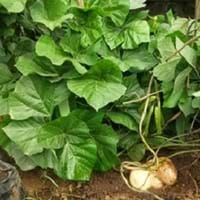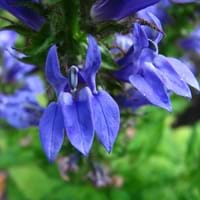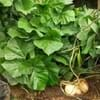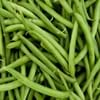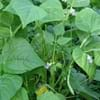Life Span
Annual or Biennial
Annual
Type
Vegetable
Flowering Plants, Shrubs
Origin
Mexico, Central America
America
Types
Mexican potato,Mexican yam bean
Lobelia aberdarica, Lobelia leschenaultiana, Lobelia canbyi
Number of Varieties
Not Available
Habitat
agricultural areas, Moist Soils, Wet ground
Open areas, River side, Woods
USDA Hardiness Zone
9-15
4-9
Sunset Zone
H1, H2, 22, 23, 24
A1, A2, A3, H1, H2, 1a, 1b, 2a, 2b, 3a, 3b, 4, 5, 6, 7, 8, 9, 10, 11, 12, 13, 14, 15, 16, 17, 18, 19, 20, 21, 22, 23, 24
Habit
Vining/Climbing
Cushion/Mound-forming
Minimum Width
Not Available
Flower Color
White, Lavender
Blue, Red, Violet, White
Flower Color Modifier
Bicolor
Bicolor
Fruit Color
Green, Tan
Not Available
Leaf Color in Spring
Green
Dark Green
Leaf Color in Summer
Green
Green
Leaf Color in Fall
Green
Green
Leaf Color in Winter
Green
Not Available
Leaf Shape
Heart-shaped
Cushion
Plant Season
Summer, Fall
Fall, Summer
Sunlight
Full Sun, Partial Sun
Full Sun, Partial shade
Type of Soil
Loam, Sand
Well drained
The pH of Soil
Acidic, Neutral
Acidic
Soil Drainage
Well drained
Well drained
Bloom Time
Early Summer, Summer
Early Fall, Early Summer, Late Summer, Mid fall, Mid Spring
Tolerances
Dry soil, Shallow soil
Not Available
Where to Plant?
Ground
Container, Ground, Pot
How to Plant?
From bulbs
Seedlings
Plant Maintenance
Medium
Medium
Watering Requirements
Keep ground moist
Form a Soil ring to water efficiently, Prefer drip-irrigation instead of Over-head watering, Requires watering in the growing season, Use Mulches to help prevent water loss during hot and windy weather, Water twice a day in the initial period
In Summer
Average Water
Lots of watering
In Spring
Moderate
Moderate
In Winter
Moderate
Average Water
Soil pH
Acidic, Neutral
Acidic
Soil Type
Loam, Sand
Well drained
Soil Drainage Capacity
Well drained
Well drained
Sun Exposure
Full Sun, Partial Sun
Full Sun, Partial shade
Pruning
Remove damaged leaves, Remove dead branches, Remove dead leaves
Cut or pinch the stems, Prune after flowering, Prune to control growth, Remove dead or diseased plant parts, Remove deadheads
Fertilizers
All-Purpose Liquid Fertilizer
All-Purpose Liquid Fertilizer
Pests and Diseases
Beetles, Leaf spot, Red blotch
Botrytis Blight, Crown rot, Pythium rot, Stem spot
Plant Tolerance
Shade areas, Shallow soil
Drought
Flower Petal Number
Single
Single
Foliage Texture
Coarse
Fine
Foliage Sheen
Glossy
Matte
Attracts
Butterflies, Mice
Birds, Hummingbirds
Allergy
Irritation to stomach, Itchiness
coma, convulsions, Diarrhea, exhaustion, Nausea, salivation, Vomiting, weakness
Aesthetic Uses
Not Used For Aesthetic Purpose
Beautification, Bouquets, Showy Purposes, Used for decorating walls, fences, gates, hedges, etc.
Beauty Benefits
Improve skin tone
Not Available
Environmental Uses
Food for animals, Soil protection
Air purification
Medicinal Uses
Cold, Fever, Inflammation
Asthma, Bronchitis, Croup
Part of Plant Used
Bulbs, Root
Leaves, Seeds
Other Uses
Used As Food
Showy Purposes
Used As Indoor Plant
No
Yes
Used As Outdoor Plant
Yes
Yes
Garden Design
Edible, Herb, Vegetable, Tropical, Vine
Bedding Plant, Bog Garden, Edging, Foundation, Hanging Basket, Houseplant, Mixed Border, Rock Garden / Wall
Botanical Name
PACHYRHIZUS erosus
Lobelia laxiflora
Common Name
Mexican Yam bean
Lobelia
In Hindi
Pachyrhizus erosus
Lobelia
In German
Yambohne
Lobelie
In French
Kłębian kątowaty
Lobelia
In Spanish
Pachyrhizus erosus
Lobelia
In Greek
Pachyrhizus erosus
λοβηλία
In Portuguese
Pachyrhizus erosus
Lobélia
In Polish
Pachyrhizus erosus
Lobelia
In Latin
Pachyrhizus erosus
Lobelia
Phylum
Angiosperms
Anthophyta
Class
Eudicotyledones
Dicotyledonae
Family
Fabaceae
Campanulaceae
Genus
Pachyrhizus
Lobelia
Clade
Angiosperms
Angiosperms, Asterids, Eudicots
Tribe
Not Available
Not Available
Subfamily
Not Available
Lobelioideae
Number of Species
Not Available
Season and Care of Jicama and Lobelia
Season and care of Jicama and Lobelia is important to know. While considering everything about Jicama and Lobelia Care, growing season is an essential factor. Jicama season is Summer and Fall and Lobelia season is Summer and Fall. The type of soil for Jicama is Loam, Sand and for Lobelia is Well drained while the PH of soil for Jicama is Acidic, Neutral and for Lobelia is Acidic.
Jicama and Lobelia Physical Information
Jicama and Lobelia physical information is very important for comparison. Jicama height is 300.00 cm and width Not Available whereas Lobelia height is 0.54 cm and width 0.38 cm. The color specification of Jicama and Lobelia are as follows:
Jicama flower color: White and Lavender
Jicama leaf color: Green
Lobelia flower color: Blue, Red, Violet and White
- Lobelia leaf color: Dark Green
Care of Jicama and Lobelia
Care of Jicama and Lobelia include pruning, fertilizers, watering etc. Jicama pruning is done Remove damaged leaves, Remove dead branches and Remove dead leaves and Lobelia pruning is done Cut or pinch the stems, Prune after flowering, Prune to control growth, Remove dead or diseased plant parts and Remove deadheads. In summer Jicama needs Average Water and in winter, it needs Moderate. Whereas, in summer Lobelia needs Lots of watering and in winter, it needs Average Water.
